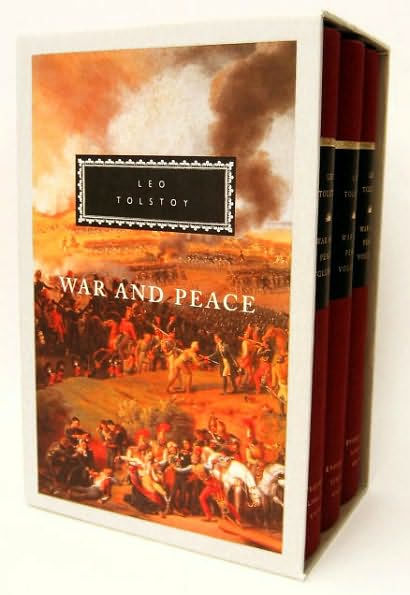War and Peace: 3-Volume Boxed Set; Introduction by R. F. Christian
A Stunning Three-Volume Boxed Set of Tolstoy’s masterwork—nominated as one of America’s best-loved novels by PBS’s The Great American Read—War and Peace.
War and Peace broadly focuses on Napoleon's invasion of Russia in 1812 and follows three of the most well-known characters in literature: Pierre Bezukhov, the illegitimate son of a count who is fighting for his inheritance and yearning for spiritual fulfillment; Prince Andrei Bolkonsky, who leaves his family behind to fight in the war against Napoleon; and Natasha Rostov, the beautiful young daughter of a nobleman who intrigues both men.
As Napoleon's army invades, Tolstoy brilliantly follows characters from diverse backgrounds—peasants and nobility, civilians and soldiers—as they struggle with the problems unique to their era, their history, and their culture. And as the novel progresses, these characters transcend their specificity, becoming some of the most moving—and human—figures in world literature.
This collector’s boxed set of War and Peace features the classic translation by Louise and Aylmer Maude.
Everyman's Library pursues the highest production standards, printing on acid-free cream-colored paper, with full-cloth cases with two-color foil stamping, decorative endpapers, silk ribbon markers, and European-style half-round spines. Everyman’s Library Classics include an introduction, a select bibliography, and a chronology of the author's life and times.
1141112274
War and Peace broadly focuses on Napoleon's invasion of Russia in 1812 and follows three of the most well-known characters in literature: Pierre Bezukhov, the illegitimate son of a count who is fighting for his inheritance and yearning for spiritual fulfillment; Prince Andrei Bolkonsky, who leaves his family behind to fight in the war against Napoleon; and Natasha Rostov, the beautiful young daughter of a nobleman who intrigues both men.
As Napoleon's army invades, Tolstoy brilliantly follows characters from diverse backgrounds—peasants and nobility, civilians and soldiers—as they struggle with the problems unique to their era, their history, and their culture. And as the novel progresses, these characters transcend their specificity, becoming some of the most moving—and human—figures in world literature.
This collector’s boxed set of War and Peace features the classic translation by Louise and Aylmer Maude.
Everyman's Library pursues the highest production standards, printing on acid-free cream-colored paper, with full-cloth cases with two-color foil stamping, decorative endpapers, silk ribbon markers, and European-style half-round spines. Everyman’s Library Classics include an introduction, a select bibliography, and a chronology of the author's life and times.
War and Peace: 3-Volume Boxed Set; Introduction by R. F. Christian
A Stunning Three-Volume Boxed Set of Tolstoy’s masterwork—nominated as one of America’s best-loved novels by PBS’s The Great American Read—War and Peace.
War and Peace broadly focuses on Napoleon's invasion of Russia in 1812 and follows three of the most well-known characters in literature: Pierre Bezukhov, the illegitimate son of a count who is fighting for his inheritance and yearning for spiritual fulfillment; Prince Andrei Bolkonsky, who leaves his family behind to fight in the war against Napoleon; and Natasha Rostov, the beautiful young daughter of a nobleman who intrigues both men.
As Napoleon's army invades, Tolstoy brilliantly follows characters from diverse backgrounds—peasants and nobility, civilians and soldiers—as they struggle with the problems unique to their era, their history, and their culture. And as the novel progresses, these characters transcend their specificity, becoming some of the most moving—and human—figures in world literature.
This collector’s boxed set of War and Peace features the classic translation by Louise and Aylmer Maude.
Everyman's Library pursues the highest production standards, printing on acid-free cream-colored paper, with full-cloth cases with two-color foil stamping, decorative endpapers, silk ribbon markers, and European-style half-round spines. Everyman’s Library Classics include an introduction, a select bibliography, and a chronology of the author's life and times.
War and Peace broadly focuses on Napoleon's invasion of Russia in 1812 and follows three of the most well-known characters in literature: Pierre Bezukhov, the illegitimate son of a count who is fighting for his inheritance and yearning for spiritual fulfillment; Prince Andrei Bolkonsky, who leaves his family behind to fight in the war against Napoleon; and Natasha Rostov, the beautiful young daughter of a nobleman who intrigues both men.
As Napoleon's army invades, Tolstoy brilliantly follows characters from diverse backgrounds—peasants and nobility, civilians and soldiers—as they struggle with the problems unique to their era, their history, and their culture. And as the novel progresses, these characters transcend their specificity, becoming some of the most moving—and human—figures in world literature.
This collector’s boxed set of War and Peace features the classic translation by Louise and Aylmer Maude.
Everyman's Library pursues the highest production standards, printing on acid-free cream-colored paper, with full-cloth cases with two-color foil stamping, decorative endpapers, silk ribbon markers, and European-style half-round spines. Everyman’s Library Classics include an introduction, a select bibliography, and a chronology of the author's life and times.
75.0
In Stock
5
1

War and Peace: 3-Volume Boxed Set; Introduction by R. F. Christian
1736
War and Peace: 3-Volume Boxed Set; Introduction by R. F. Christian
1736
75.0
In Stock

Product Details
| ISBN-13: | 9780679405733 |
|---|---|
| Publisher: | Knopf Doubleday Publishing Group |
| Publication date: | 12/07/1992 |
| Series: | Everyman's Library Classics Series |
| Edition description: | BOXED |
| Pages: | 1736 |
| Sales rank: | 280,865 |
| Product dimensions: | 5.47(w) x 8.50(h) x 4.00(d) |
| Lexile: | 1200L (what's this?) |
About the Author

From the B&N Reads Blog
